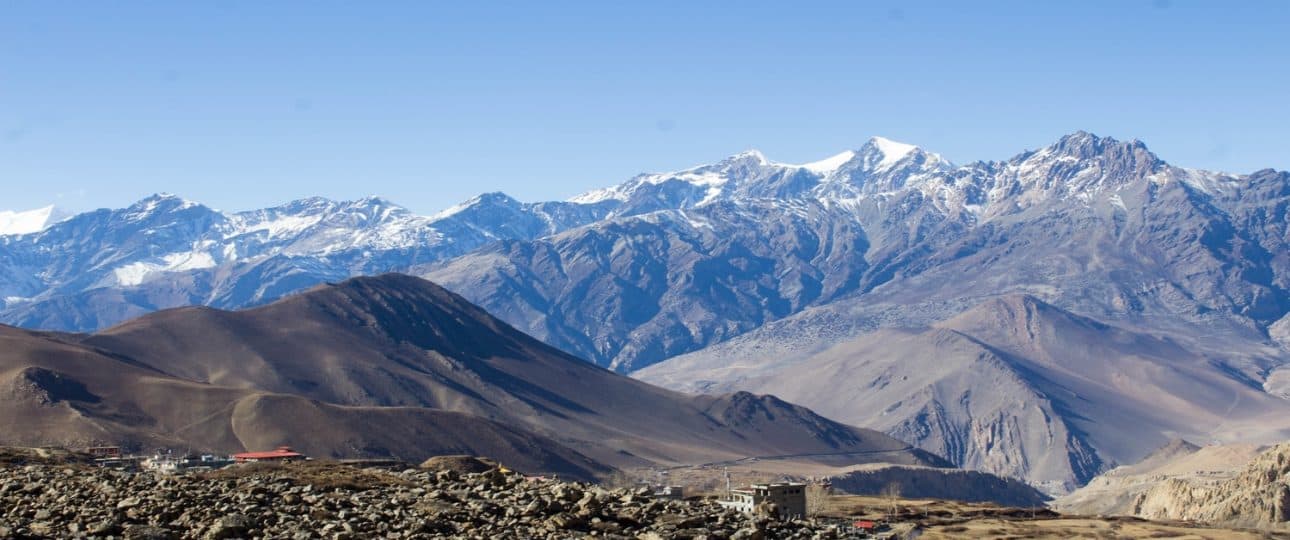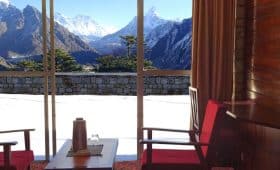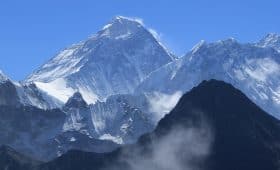Packing right gear and clothing will make your trekking experience to Everest Base Camp trek in May a comfortable one. And, it is important to pack light with the necessaries. Over-packing adds burden to your journey.
In Nepal, May is the last month of Spring, just before the monsoon arrives. Planning Everest Base Camp packing list in May could be a bit tricky.
During May, you can expect bright sunshine or warm sunny weather with clear blue sky. Hence this is the reason Everest summits occur during this month and is also the peak season.
Everest Base Camp trek takes you from altitudes of 2840 meters to 5545 meters. The temperature and weather changes frequently as you ascend. As you climb up to higher altitude you will need more layer of clothes.
Thus for EBC trekking in May, you will need to pack a mixture of light warm clothes to heavy cold weather clothes.
Packing the right clothing and gears plays a vital role in making your trekking experience comfortable and smooth. And for that, it is wise to know the weather condition prior to the trek and pack accordingly.
To help with this, here we have a guideline on what to pack for EBC trek in May.

Table of Contents
Everest Base Camp Packing List for May
During May the EBC weather is mild. The daytime temperature generally reaches high as around 15-degree Celsius. And the night time average minimum temperature drops down to around 0-degree Celsius.
In may you can expect the sun to shine for an average of 8 to 9 hours per days which is great for trekking because you don’t have to rush to the teahouse before it gets dark.
While trekking in the lower region the temperature is mild to moderate. But as you ascend the temperature drops and the mornings and nights are cold.
So, packing for May can be tricky and you have to prepare yourselves for any kind of weather.

Clothing
Base Layer: 2 quick-drying base layer shirts and 2 quick drying full pants
This is the first layer of clothing for the colder parts of the trek which is at the higher altitudes.
As you ascend higher, the temperature tends to drop compared to lower regions. The mornings and nights are quite cold. Hence having a comfortable and warm base layer will help you stay warm.
Insulation Layer: 1 Fleece Jacket and 1 Fleece Bottoms
This is the second layer of clothing made from fleece. It is a warm and soft layer which are great for cold nights.
Besides you can opt for sleeveless puffer jackets or Gilets according to your preference.
Third Layer: 1 wind/rainproof outer layer- jacket and pants.
This third layer is the outer core layer that consists of a warm and waterproof jacket and trousers.
This is a good piece and is useful for all types of cold weather in the higher altitudes.
Want more information? Send us your query, and our experts will get back to you within 24 hrs.
General Trekking Clothes
Along with the three layers, you also need regular hiking clothes. And they are,
Trekking trousers and shorts: 1 pair of trekking trousers or shorts. You can even opt for hiking trousers that are convertible into shorts.
Trekking Shirts: 2 long and short sleeve shirts
While trekking it is wise to carry shirts that are not made from cotton. The reason being, while trekking you tend you sweat and hence your skin is moist. And cotton absorbs the moisture from the skin which may cause odor, rashes, and discomfort.
Hence take clothing that is of moisture-wicking fabric. They are lightweight, breathable and quick to dry.
Inner Garment: 5 to 6 pairs of underwear and 3 sports bra
It goes the same for the inner garment that the materials you take are breathable and moisture wicking.
Bra
As for the bra, carrying a good pair of sports bra provides the right support needed for the long walks, unlike regular bra.
The advantage of taking a moisture wicking material is it is easy to wash and dry. This comes in handy when you want to wash and reuse your underwear at teahouses.
Headwear
Hat
Since it is warm during the month of May you will need a good wide brim hiking hat. This will protect your face from the scorching sun during the day.
It is best if it is lightweight, easy to pack and has coverage even on your neck. Since the average sunshine is 8 to 9 hours in May. You will be out in the sun and hence protecting yourself from the sun is important during your Everest Base Camp trek.
Beanie
You can carry a beanie for the cold mornings and nights at the higher altitudes of your EBC trek. In May carrying one beanie is enough since the temperature is milder compared to other colder months.
Neck Gaiter
A neck gaiter is useful to protect your face and neck from the elements like cold and wind. It is also light and easy to pack which wouldn’t eat up your space.
Gloves
Hands are one of the most exposed parts of your body. You will want to keep them warm esp during the colder parts of your trek.
Carry an insulated glove that is warm, waterproof and durable. This will help in keeping your hands nice and warm. They must be suitable for sub-zero temperature. You will face the temperature on the high altitudes of Gorakshep.
Footwear
A good pair of footwear is a must while trekking. You will be walking for 5-6 hours on daily and having a good footwear can make or break your trekking journey.
Hence it is important that you have the following for a comfortable experience to the EBC:
Hiking Boots
A pair of hiking boots with ankle support is great for any trek. They should be comfortable. You can try them on before the trek so that you don’t face problem while on a trek. While you try them, do it along with the trekking socks.
Find a pair that is light to mid-weight hiking boots. Boots that are heavy can take a toll on your feet.
Also, make sure it has deep cut traction and is waterproof. This is essential as the trail can be wet due to snow at the higher altitudes.
A good ankle support and grip is necessary for a safe trek.
Trekking Shoes / Sandals
A pair of trekking shoes and sandals are great to relax your feet after the day’s hike.
These are great while you have spare time where you would like to explore the tea houses in the EBC route. Also, for bathroom use and while resting in cafes and restaurants.
Carry sandals that you can use even with your socks on. This is because you do not want to walk barefoot without socks in the cold weather at higher altitudes.
Hiking Socks: 5-6 pairs of hiking socks
By now you must know that we cannot stress enough to carry stuff that is breathable and moisture wicking. So make sure your socks serve the same purpose.
Also, carry enough pairs that will last for your entire trip. Having an extra won’t hurt because these things are small and don’t eat up much space.
You can always sneak them anywhere in your backpacks. And you want to be able to change it quite often and not have smelly feet.
Warm Thermal Socks:1 or 2 pairs of Thermal socks
Carry thermal socks that are thicker than trekking socks. These are useful for the cold weather.
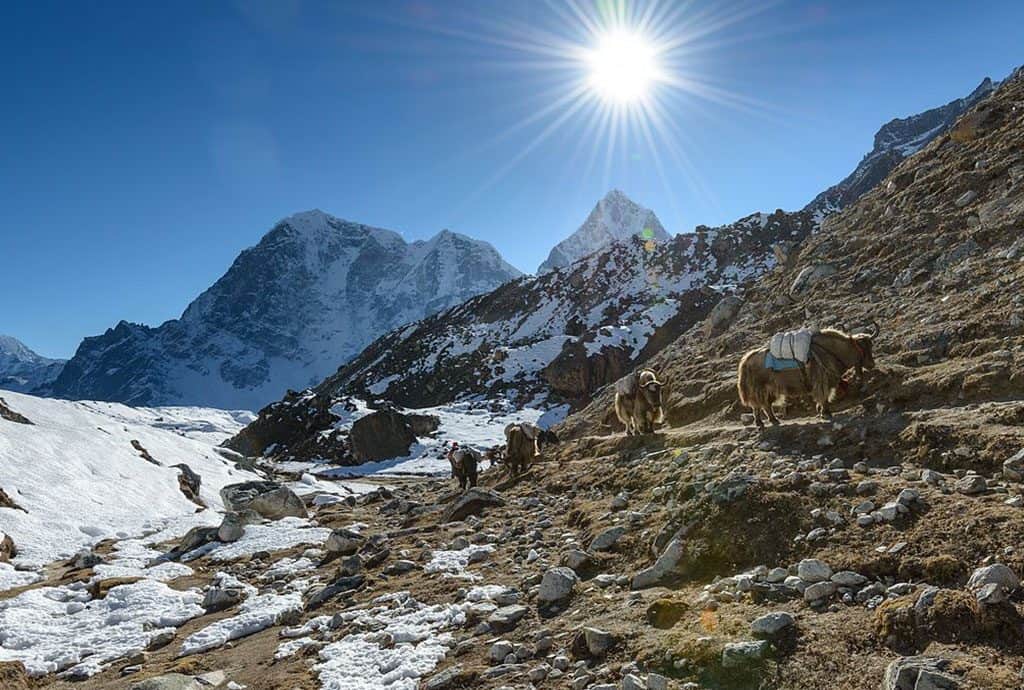
Gaiters
Gaiters cover the ankle-high opening to your boots. These prevent water, mud, pebbles, and leeches from getting into them. Having a pair can be great in May.
Sleeping Gear
Sleeping Bag
The rooms in the tea houses on Everest Base Camp trek do not have good insulation. Though they provide blankets, having a sleeping bag with insulation is great for that extra warmth esp at night.
For May a warm sleeping bag with at least -10 degree Celsius is good enough.
Liner
Carrying a liner is helpful because it is easier to change and wash and also for the extra warmth.
Ear Plugs
If you are someone who sleeps light, earplugs can be very useful. This will block out the snores and loud noises and wind howls.
After walking for hours during the day. It is important that you get a good sleep at night so that you are fresh for the next day. So it is wise to take them if you are someone who can easily get disturbed.
Bags and Backpacks
Duffel Bag
A duffel bag is the best option if you hire a porter. Your duffle bag should be durable and water resistant. It should be large enough to hold anywhere between 70L to 90L.
This size is usually great for the Everest Base Camp trek.
Backpack
Having a good and sturdy backpack is the right decision if you are carrying your own luggage. This backpack should be able to hold all your belonging.
So make sure it is as big. For EBC trek, a 50 to 65L backpack should be fine. It is important that this backpack has easy access holders for your water bottle. And other things like documents, snacks, and cash that you need during the day.
Daypack
You can carry a daypack even if you hire a porter. And in this daypack, you can include a water bottle, snacks and basically the essentials that you can easily take out whenever in need.
Raincover
Carrying a cover for your bags is a must. This cover will serve as an all-rounder that will protect your bag from any kind of climatic conditions or elements. Such as rain, dust, wind, snow, and insects etc.
And make sure it is the right size for your bag. This is something you will need in all months because it will keep your belongings clean.
Dry Bag
Carry dry bags to isolate the dirty clothes from the clean ones.
Trekking Equipment and Supplies
Trekking Poles
Trekking poles that are lightweight and portable are great for any trek. It is always great for balance and support. They are very helpful in the steep ascend and descends.
Sunglasses
Make sure to carry a good pair of UV protecting sunglasses. Bright sun and the glare from the snow-covered peaks are harmful to your eyes.
Hence you should carry a sunglass with 100% UV protection.
Headlight
Carrying a headlight is more convenient than carrying a flashlight. Most of the tea houses in the Everest Base Camp have poor lighting.
Headlamps come in handy while moving around the tea houses at late nights or early mornings.
Water Bottle
Drinking enough water and staying hydrated is very important for a safe and comfortable trek.
Having a reusable water bottle is great for the environment. It is also cheaper compared to mineral water bottles.
Also, the temperature at high altitudes of Everest Base Camp can be below freezing. Thus it is important that you have a good quality flask which will keep your water warm and prevent from freezing.
Lock
During May since it is the peak season, the number of trekkers will be significantly high. Having a secure lock for your bags can be a good idea to keep your belongings safe.

Toiletries and Others
Towel
Having a personal towel is necessary for hygiene. You can carry lightweight and easy drying towels so that it dries fast and don’t end up smelling.
Pee Funnel
It is difficult to find toilets on the higher altitudes. Hence having a pee funnel is a great option.
Controlling your bladder can be bad for your health and can make you uncomfortable. With this, you can release the bladder without having to hold up for too long.
Sunscreen
Sunscreen is a must for your face and other exposed parts of your body. It is wise to carry a sunscreen with a minimum SPF 30. Also, do not forget to carry a UV rated lip balm.
Baby Wipes, Hand Sanitizers
These are great for cleaning your hands whenever you feel the need to. But while using wipes make sure you collect them after use and throw them in the dustbin while you are in the tea house.
It is important that we take in charge of keeping the environment clean and don’t litter anywhere and everywhere.
Toiletries
- Toothpaste, toothbrush, shampoo, conditioner
- Rolls of toilet paper
- Multi-purpose Soap
- Female hygiene products
Gadget and Entertainment
Camera
Trekking into the mountains such as the EBC trek is a once in a lifetime experience. There is no doubt that you will get plenty of opportunities to click amazing pictures.
Having a good camera to click moments of this beautiful journey is a must.
Portable Charger
By carrying a portable charger you will always have the means to recharge any electronics like mobile phones, camera etc.
Though most tea houses have charging facility. They are not reliable all the time. Also trekking in May means a lot of trekkers on the trials.
During this time you will most likely have to wait in a queue to charge your electronics. Also, this comes with an extra cost.
Books
During your spare time in the tea houses, you can read books. Hence do not forget to carry books if you are someone who loves reading.
Documents
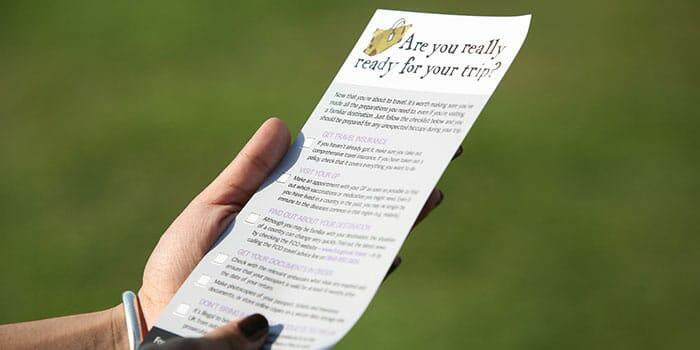
Passport
Always make sure to have your passport with you at all times. Also, it is wise to keep a few copies of your passport. These come in handy to get local sim cards, permits, registration and so on.
Permits
You will need to carry permits to trek to Everest Base camp. They are the TIMS card and the Sagarmatha National Park entry permit.
Cash
The tea houses in the trials do not accept cards. Moreover, there are very few ATMs which are not completely reliable.
Hence be sure to have enough local currency to last for the entire duration till you are back in the city.
Insurance
Trekking into the mountains in high altitudes comes with various risks. Having a travel insurance is important. This is a great safety precaution for high altitude trek such as the EBC trek.
Your insurance should cover emergency evacuation and rescue facilities. Also, make sure it covers altitudes up to 6000m.
Medications
Water Purification Tablets
Purifying water before you drink is very important. This is useful against water contamination. These can be iodine tablets, water purification gels, Steripens etc.
First Aid Kit
Carrying a first aid kit can be very useful for any kind of emergency treatment not only for you but for the fellow trekkers in need.
Make sure to include common medications like Paracetamol, Imodium. Also, include Diamox. On high altitude treks like these, Diamox can come in handy to prevent the onset of Acute Mountain Sickness.
Plasters
Blister plasters- For small cuts and blisters
Regular fabric plasters
Snacks
You will not find teahouses in every step of the way in case you are hungry or low on energy. Hence carry snacks like nuts, almonds and Granola bars for that quick boost of energy.
NOTE: The list given above is just a guideline. The packing list is not final. You should definitely customize according to your need and preferences.
Last Say,
Having an appropriate clothing and supplies are essential for a smooth and successful trip.
Packing for Everest Base Camp trek in May is far easier than packing for cold winter months. You do not have to worry about packing bulky stuff because the weather is pleasant during this time.
Trekking to EBC in May is undoubtedly an ideal time to trek.
For further question and queries, please feel to contact us. It is our pleasure to plan the trek for you and make sure it is successful.
Want more information? Send us your query, and our experts will get back to you within 24 hrs.
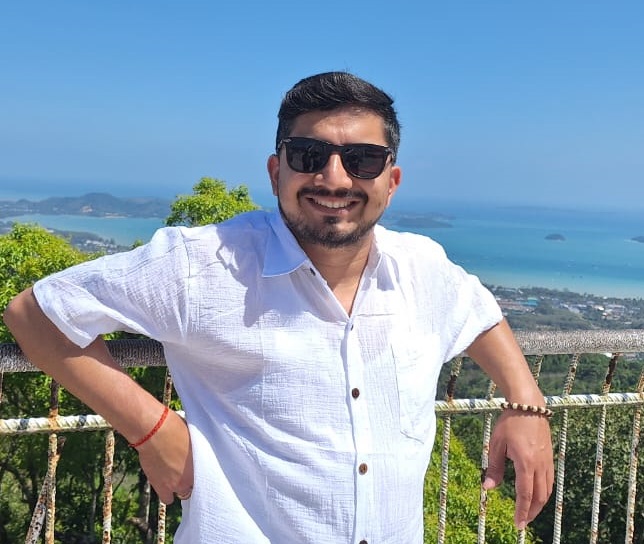
Madhav started working as a porter in 2001 and then moved on to work as a trekking guide. After working in the trekking and tourism industry for eight years, he co-founded Mosaic Adventure in 2009.
Madhav has trekked to most of the trekking destinations in Nepal, including Everest Base Camp Trek, Annapurna Base Camp, Annapurna Circuit Trek, Poon Hill Trek, Jomsom Muktinath Trek, Indigenous Peoples Trek, Langtang Valley Trek, Mardi Himal Trek, and all of the day hikes around Kathmandu.
He has also extensively traveled to other countries such as Australia, the USA, the UK, France, Hong Kong, Japan, China, the Philippines, the UAE, Saudi Arabia, Bahrain, Thailand, Turkey, and India. Madhav is the one who answers most of your questions about trekking and tours and helps to plan your trip by giving a personal touch.

